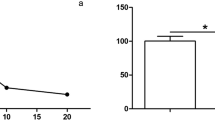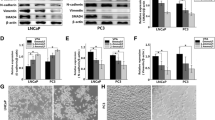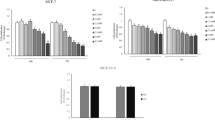Abstract
Valproic acid (VPA) is a selective histone deacetylation (HDAC) inhibitor and exerts anti-cancer properties in different types of cancer. The epithelial-to-mesenchymal transition (EMT) mediating by different signaling cascade can be a potential target in aggressive human cancers. Therefore, we aimed to clarified the unravel relationship between AKT/GSK3β/β-catenin signalling pathway and VPA-induced EMT in triple negative breast cancer (TNBC). The cytotoxicity of VPA in MDA-MB-231 TNBC and MCF-10A control cells was evaluated. Alterations in the expression levels of Snail, E-cadherin, AKT, GSK3β, β-catenin were analyzed by RT-PCR. Additionally, Annexin V, cell cycle and wound healing assays were performed. Our results showed that VPA remarkably inhibited the growth of TNBC cell and triggered apoptotic cell death through G0/G1 arrest. Furthermore, VPA increased cell migration and activated the EMT process through significantly increasing Snail expression and in turn downregulation of E-cadherin and GKS3β levels. However, the level of AKT and β-catenin was reduced after treatment of VPA. Our data showed that VPA induced EMT process and cell migration in TNBC cells. However, AKT/GSK3β/β-catenin signaling pathway did not mediate EMT activation.





Similar content being viewed by others
References
Marsoni S, Damia G, Camboni G (2008) A work in progress: the clinical development of histone deacetylase inhibitors. Epigenetics 3:164–171 https://doi.org/10.4161/epi.3.3.6253
Heers H, Stanislaw J, Harrelson J, Lee MW (2018) Valproic acid as an adjunctive therapeutic agent for the treatment of breast cancer. Eur J Pharmacol 835:61–74 https://doi.org/10.1016/j.ejphar.2018.07.057
Li Y, Seto E (2016) HDACs and HDAC inhibitors in cancer development and therapy. Cold Spring Harb Perspect Med 6:a026831 https://doi.org/10.1101/cshperspect.a026831
Behera J, Jayaprakash V, Sinha BN (2015) Histone deacetylase inhibitors: a review on class-I specific inhibition. Mini Rev Med Chem 15(9):731–750 https://doi.org/10.2174/1389557515666150521162237
Suraweera A, O'Byrne KJ, Richard DJ (2018) Combination therapy with histone deacetylase inhibitors (HDACi) for the treatment of cancer: achieving the full therapeutic potential of HDACi. Front Oncol 8:92 https://doi.org/10.3389/fonc.2018.00092
Fang MH, Ji XM (2009) Histone modification and its application in therapy for hematologic malignancies. Zhongguo Shi Yan Xue Ye Xue Za Zhi 17(3):816–820
Namdar M, Perez G, Ngo L, Marks PA (2010) Selective inhibition of histone deacetylase 6 (HDAC6) induces DNA damage and sensitizes transformed cells to anticancer agents. Proc Natl Acad Sci U S A 107(46):20003–20008 https://doi.org/10.1073/pnas.1013754107
Rodrigues C, Chhun S, Chiron C, Dulac O, Rey E, Pons G, Jullien V (2018) A population pharmacokinetic model taking into account protein binding for the sustained-release granule formulation of valproic acid in children with epilepsy. Eur J Clin Pharmacol 74(6):793–803. https://doi.org/10.1007/s00228-018-2444-2
Khan S, Ahirwar K, Jena G (2016) Anti-fibrotic effects of valproic acid: role of HDAC inhibition and associated mechanisms. Epigenomics 8(8):1087–1101 https://doi.org/10.2217/epi-2016-0034
Tran LNK, Kichenadasse G, Butler LM, Centenera MM, Morel KL, Ormsby RJ, Michael MZ, Lower KM, Sykes PJ (2017) The combination of metformin and valproic acid induces synergistic apoptosis in the presence of p53 and androgen signaling in prostate cancer. Mol Cancer Ther 16(12):2689–2700 https://doi.org/10.1158/1535-7163.MCT-17-0074
Göttlicher M, Minucci S, Zhu P, Krämer OH, Schimpf A, Giavara S, Sleeman JP, Lo Coco F, Nervi C, Pelicci PG, Heinzel T (2001) Valproic acid defines a novel class of HDAC inhibitors inducing differentiation of transformed cells. EMBO J 20(24):6969–6978 https://doi.org/10.1093/emboj/20.24.6969
Tinari N, De Tursi M, Grassadonia A, Zilli M, Stuppia L, Iacobelli S, Natoli C (2012) An epigenetic approach to pancreatic cancer treatment: the prospective role of histone deacetylase inhibitors. Curr Cancer Drug Targets 12(4):439–452 https://doi.org/10.2174/156800912800190884
Travaglini L, Vian L, Billi M, Grignani F, Nervi C (2009) Epigenetic reprogramming of breast cancer cells by valproic acid occurs regardless of estrogen receptor status. Int J Biochem Cell Biol 41(1):225–234 https://doi.org/10.1016/j.biocel.2008.08.019
Mawatari T, Ninomiya I, Inokuchi M, Harada S, Hayashi H, Oyama K, Makino I, Nakagawara H, Miyashita T, Tajima H, Takamura H, Fushida S, Ohta T (2015) Valproic acid inhibits proliferation of HER2-expressing breast cancer cells by inducing cell cycle arrest and apoptosis through Hsp70 acetylation. Int J Oncol 47(6):2073–2081 https://doi.org/10.3892/ijo.2015.3213
Kelkar MG, Senthilkumar K, Jadhav S, Gupta S, Ahn BC, De A (2016) Enhancement of human sodium iodide symporter gene therapy for breast cancer by HDAC inhibitor mediated transcriptional modulation. Sci Rep 6:19341 https://doi.org/10.1038/srep19341
Kalluri R (2009) EMT: when epithelial cells decide to become mesenchymal-like cells. J Clin Invest 119(6):1417–1419 https://doi.org/10.1172/JCI39675
Micalizzi DS, Farabaugh SM, Ford HL (2010) Epithelial-mesenchymal transition in cancer: parallels between normal development and tumor progression. J Mammary Gland Biol Neoplasia 15(2):117–134 https://doi.org/10.1007/s10911-010-9178-9
Giudice FS, Pinto DS Jr, Nör JE, Squarize CH, Castilho RM (2013) Inhibition of histone deacetylase impacts cancer stem cells and induces epithelial-mesenchyme transition of head and neck cancer. PLoS One 8(3):e58672 https://doi.org/10.1371/journal.pone.0058672
Cha YH, Yook JI, Kim HS, Kim NH (2015) Catabolic metabolism during cancer EMT. Arch Pharm Res 38(3):313–320 https://doi.org/10.1007/s12272-015-0567-x
Wu L, Feng H, Hu J, Tian X, Zhang C (2016) Valproic acid (VPA) promotes the epithelial mesenchymal transition of hepatocarcinoma cells via transcriptional and post-transcriptional up regulation of snail. Biomed Pharmacother 84:1029–1035 https://doi.org/10.1016/j.biopha.2016.10.023
Marquez-Curtis LA, Qiu Y, Xu A, Janowska-Wieczorek A (2014) Migration, proliferation, and differentiation of cord blood mesenchymal stromal cells treated with histone deacetylase inhibitor valproic acid. Stem Cells Int 2014:610495 https://doi.org/10.1155/2014/610495
Zhang S, Tang Z, Qing B, Tang R, Duan Q, Ding S, Deng D (2019) Valproic acid promotes the epithelial-to-mesenchymal transition of breast cancer cells through stabilization of snail and transcriptional upregulation of Zeb1. Eur J Pharmacol 865:172745 https://doi.org/10.1016/j.ejphar.2019.172745
Viswanathan VS, Ryan MJ, Dhruv HD et al (2017) Dependency of a therapy-resistant state of cancer cells on a lipid peroxidase pathway. Nature 547(7664):453–457 https://doi.org/10.1038/nature23007
Zheng H, Li W, Wang Y, Liu Z, Cai Y, Xie T, Shi M, Wang Z, Jiang B (2013) Glycogen synthase kinase-3 beta regulates snail and β-catenin expression during Fas-induced epithelial-mesenchymal transition in gastrointestinal cancer. Eur J Cancer 49(12):2734–2746 https://doi.org/10.1016/j.ejca.2013.03.014
Xu W, Yang Z, Lu N (2015) A new role for the PI3K/Akt signaling pathway in the epithelial-mesenchymal transition. Cell Adhes Migr 9(4):317–324 https://doi.org/10.1080/19336918.2015.1016686
Clevers H, Nusse R (2012) Wnt/β-catenin signaling and disease. Cell 149(6):1192–1205 https://doi.org/10.1016/j.cell.2012.05.012
Ma XJ, Wang YS, Gu WP, Zhao X (2017) The role and possible molecular mechanism of valproic acid in the growth of MCF-7 breast cancer cells. Croat Med J 58(5):349–357 https://doi.org/10.3325/cmj.2017.58.349
Zhang L, Wang G, Wang L, Song C, Leng Y, Wang X, Kang J (2012) VPA inhibits breast cancer cell migration by specifically targeting HDAC2 and down-regulating Survivin. Mol Cell Biochem 361(1–2):39–45 https://doi.org/10.1007/s11010-011-1085-x
Pai SG, Carneiro BA, Mota JM, Costa R, Leite CA, Barroso-Sousa R, Kaplan JB, Chae YK, Giles FJ (2017) Wnt/beta-catenin pathway: modulating anticancer immune response. J Hematol Oncol 10(1):101 https://doi.org/10.1186/s13045-017-0471-6
Padmanaban V, Krol I, Suhail Y, Szczerba BM, Aceto N, Bader JS, Ewald AJ (2019) E-cadherin is required for metastasis in multiple models of breast cancer. Nature 573(7774):439–444 https://doi.org/10.1038/s41586-019-1526-3
Shang S, Hua F, Hu ZW (2017) The regulation of β-catenin activity and function in cancer: therapeutic opportunities. Oncotarget 8(20):33972–33989 https://doi.org/10.18632/oncotarget.15687
Huels DJ, Ridgway RA, Radulescu S, Leushacke M, Campbell AD, Biswas S et al (2015) E-cadherin can limit the transforming properties of activating β-catenin mutations. EMBO J 14;34(18):2321–2333 https://doi.org/10.15252/embj.201591739
Ryu WJ, Lee JD, Park JC, Cha PH, Cho YH, Kim JY, Sohn JH, Paik S, Choi KY (2020) Destabilization of β-catenin and RAS by targeting the Wnt/β-catenin pathway as a potential treatment for triple-negative breast cancer. Exp Mol Med 52:832–842 https://doi.org/10.1038/s12276-020-0440-y
Shen T, Zhang K, Siegal GP, Wei S (2016) Prognostic value of E-cadherin and β-catenin in triple-negative breast cancer. Am J Clin Pathol 146(5):603–610. https://doi.org/10.1093/ajcp/aqw183
Borcherding N, Cole K, Kluz P, Jorgensen M, Kolb R, Bellizzi A, Zhang W (2018) Re-evaluating E-cadherin and β-catenin: a pan-cancer proteomic approach with an emphasis on breast cancer. Am J Pathol 188(8):1910–1920. https://doi.org/10.1016/j.ajpath.2018.05.003
Song M, Bode AM, Dong Z, Lee MH (2019) AKT as a therapeutic target for cancer. Cancer Res 79(6):1019–1031 https://doi.org/10.1158/0008-5472.CAN-18-2738
Duda P, Akula SM, Abrams SL, Steelman LS, Martelli AM, Cocco L et al (2020) Targeting GSK3 and associated signaling pathways involved in cancer. Cells 9(5):1110 https://doi.org/10.3390/cells9051110
Xia Q, Zheng Y, Jiang W, Huang Z, Wang M, Rodriguez R, Jin X (2016) Valproic acid induces autophagy by suppressing the Akt/mTOR pathway in human prostate cancer cells. Oncol Lett 12(3):1826–1832 https://doi.org/10.3892/ol.2016.4880
Shi P, Yin T, Zhou F, Cui P, Gou S, Wang C (2014) Valproic acid sensitizes pancreatic cancer cells to natural killer cell-mediated lysis by upregulating MICA and MICB via the PI3K/Akt signaling pathway. BMC Cancer 14:370 https://doi.org/10.1186/1471-2407-14-370
Zhang C, Liu S, Yuan X, Hu Z, Li H, Wu M, Yuan J, Zhao Z, Su J, Wang X, Liao Y, Liu Q (2016) Valproic acid promotes human glioma U87 cells apoptosis and inhibits glycogen synthase kinase-3β through ERK/Akt signaling. Cell Physiol Biochem 39(6):2173–2185 https://doi.org/10.1159/000447912
Funding
No funds, grants, or other support was received.
Author information
Authors and Affiliations
Contributions
ZO, BOI, ES,GGE, ADO and SK conceptualized, design and coordinated the investigation. ZO, BOI, GGE and ADO conducted the analyses and coordinated the investigation. ES an SK analyzed the data and carried out the statistical analysis. All authors participated in writing, reading and approval of the final manuscript.
Corresponding author
Ethics declarations
Conflict of interest
The authors have no conflicts and financial of interest to declare that are relevant to the content of this article.
Ethics approval
No ethics approval was received for conducting this study.
Additional information
Publisher’s Note
Springer Nature remains neutral with regard to jurisdictional claims in published maps and institutional affiliations.
Rights and permissions
About this article
Cite this article
Ozman, Z., Ozbek Iptec, B., Sahin, E. et al. Regulation of valproic acid induced EMT by AKT/GSK3β/β-catenin signaling pathway in triple negative breast cancer. Mol Biol Rep 48, 1335–1343 (2021). https://doi.org/10.1007/s11033-021-06173-8
Received:
Accepted:
Published:
Issue Date:
DOI: https://doi.org/10.1007/s11033-021-06173-8




